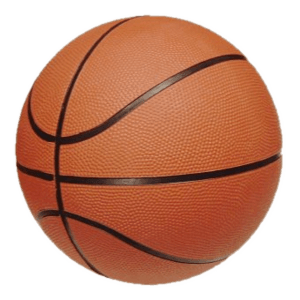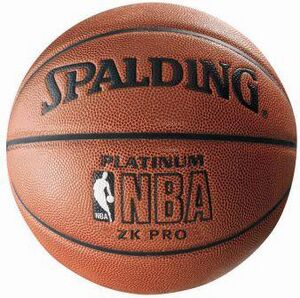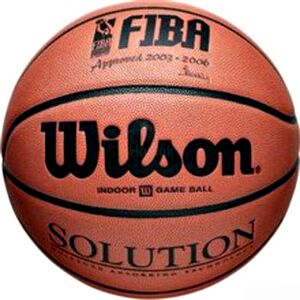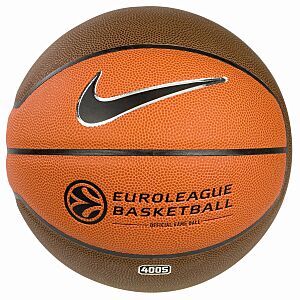Basketball (ball) facts for kids
A basketball is a round ball used to play the game of basketball. These balls come in many sizes, from small ones for fun to larger ones used in training. For example, a youth basketball might be about 69 centimeters (27 inches) around. A men's professional ball, like in the National Basketball Association (NBA), is about 75 centimeters (29.5 inches) around. Women's professional balls, like in the Women's National Basketball Association (WNBA), are slightly smaller, about 72 centimeters (28.5 inches) around. High school and junior leagues usually use balls similar to these sizes.
Besides the court and the hoops, the basketball is the only thing you need to play. During a game, players must bounce the ball (this is called dribbling). They also throw it to teammates (passing) or shoot it towards the basket (shooting). Because of this, the ball needs to be strong and easy to hold. Players also use basketballs for cool tricks, like spinning the ball on a finger or doing fancy dribbling moves. Some even do acrobatic tricks with the ball during a slam dunk contest.
Contents
What Makes a Basketball Special?
Almost all basketballs have an air-filled rubber balloon inside. This balloon is usually wrapped with layers of strong fibers. Then, it's covered with an outer surface. This surface can be made from leather (the traditional material), rubber, or a mix of materials called a synthetic composite. Like most balls filled with air, there's a small opening. This lets you add or remove air to change the ball's pressure.
Ball Design and Colors
The surface of a basketball almost always has "ribs." These are lines that are slightly lower than the rest of the ball. They help players grip the ball better. These ribs are usually a different color from the main surface. The most common look for a basketball is an orange surface with black ribs. Sometimes, there's also a logo. However, basketballs come in many different colors. A famous example is the red, white, and blue basketball. This ball was used in the American Basketball Association and by the Harlem Globetrotters. It's also used as the special "money ball" in the NBA All-Star Weekend's Three Point Contest.
Indoor vs. Outdoor Basketballs
Basketballs are usually made for either indoor use or for all surfaces (meaning indoor and outdoor). Indoor balls are often made of leather or special materials that soak up sweat. All-surface balls are usually made of rubber or strong composite materials. They are also called indoor/outdoor balls. Indoor balls usually cost more because of the materials they use. Also, brand new leather indoor balls need to be "broken in." This means they need to be used a bit to get the best grip before a real game. Playing with an indoor ball on rough outdoor courts, like asphalt, can ruin it quickly. That's why an indoor/outdoor ball is better for playing outside. Outdoor balls are often made of rubber to handle tougher conditions. They also need more air to stay firm in colder weather.
Basketball Sizes for Different Ages
Different sizes of basketballs are used for different age groups. Here are the common standards:
| Size | Type | Around the Ball | Weight | Who Uses This Size? |
|---|---|---|---|---|
| 7 | Men | 75–77 cm (29.5–30.3 in) | 580–620 g (20.5–21.9 oz) | For men and boys aged 15 and older. This is the official size for men's high school, college, and professional games. |
| 6 | Women | 71.5–73 cm (28.1–28.7 in) | 510–550 g (18.0–19.4 oz) | For boys aged 12–14. Also for women and girls aged 12 and older. This is the official size for women's high school, college, and professional games. |
| 5 | Youth (North America) Mini (FIBA) |
68.5–70 cm (27.0–27.6 in) | 465–495 g (16.4–17.5 oz) | For children aged 9–11 years old. This is the standard youth basketball. |
| 4 | Youth (North America) | 65 cm (25.5 in) | 400 g (14 oz) | For children aged 5–8 years old. |
| 3 | Mini (North America) | 56 cm (22.0 in) | 280 g (10 oz) | For children aged 4–8 years old. Also known as a "mini" basketball. |
For the fast-paced 3x3 game, which is played on half a court, a special ball is used. It has the same size as a size 6 ball but weighs the same as a size 7 ball. This makes it easier to handle in the quicker 3x3 game.
The History of the Basketball
In December 1891, a physical education teacher named James Naismith was asked to invent a new game. He worked at the School for Christian Workers in Springfield, Massachusetts. He wanted a game that would keep athletes busy during the winter. Naismith gathered 18 young men. He divided them into two teams of nine players. They played the very first basketball game using a soccer ball and two peach baskets as hoops.
The first basketballs made just for the game were different from soccer balls. They were made from leather panels sewn together with a rubber bladder inside. A cloth lining was added to make the ball stronger and keep its shape. In 1942, a new way to make basketballs was invented, using molds. For many years, leather was the top choice for basketball covers. However, in the late 1990s, new synthetic materials became popular. Most leagues started using them. But the NBA still uses real leather game balls. (They tried a different material briefly in 2006, but players didn't like it.)
From 1967 to 1976, the American Basketball Association (ABA) used a unique red, white, and blue basketball. This colorful ball is still used today in the NBA's three-point contest.
Who Makes Basketballs?
Many companies make basketballs for players all over the world. Here are some of the most famous ones:
- Spalding
Spalding was the first company to make an official basketball. The founder, A. G. Spalding, made the first special basketball in the late 1800s because James Naismith asked him to. Spalding has made basketballs ever since. They were the official ball supplier for the NBA from 1983 to 2021. They also made balls for the WNBA and the NBA G League. Spalding makes many different kinds of balls for people to buy.
- Molten
Molten is a Japanese company that makes sports equipment. They provide game balls for many important basketball events. This includes all International Basketball Federation (FIBA) world championships and qualifying games. They also supply balls for many leagues around the world, like in Australia, Argentina, and Italy. Molten's best ball is the GL7, which is a leather ball with a special 12-panel design.
- Wilson
Wilson Sporting Goods is the official ball supplier for all NCAA (college basketball) postseason tournaments. This includes the famous men's and women's Division I tournaments. Many college teams use Wilson balls during their regular season, as do many high school leagues. Since 2015, Wilson has supplied balls for all FIBA 3x3 competitions. Wilson also makes many different balls for people to buy. They were the NBA's official ball supplier from 1946 to 1983, and they became the supplier again in 2021.
- Nike
Nike used to make balls for the Euroleague Basketball competitions from 2007 to 2012. In the Philippines, the NCAA (which is different from the American NCAA) and UAAP leagues use Nike 4005 Official Tournament Balls.
- Others
Many other companies also make basketballs. Some of these include Adidas, Baden Sports (which supplies balls for the Harlem Globetrotters), Dunlop, Tarmak, Mikasa, Mitre, Puma, and And1.
See also
 In Spanish: Balón de baloncesto para niños
In Spanish: Balón de baloncesto para niños
- List of inflatable manufactured goods






